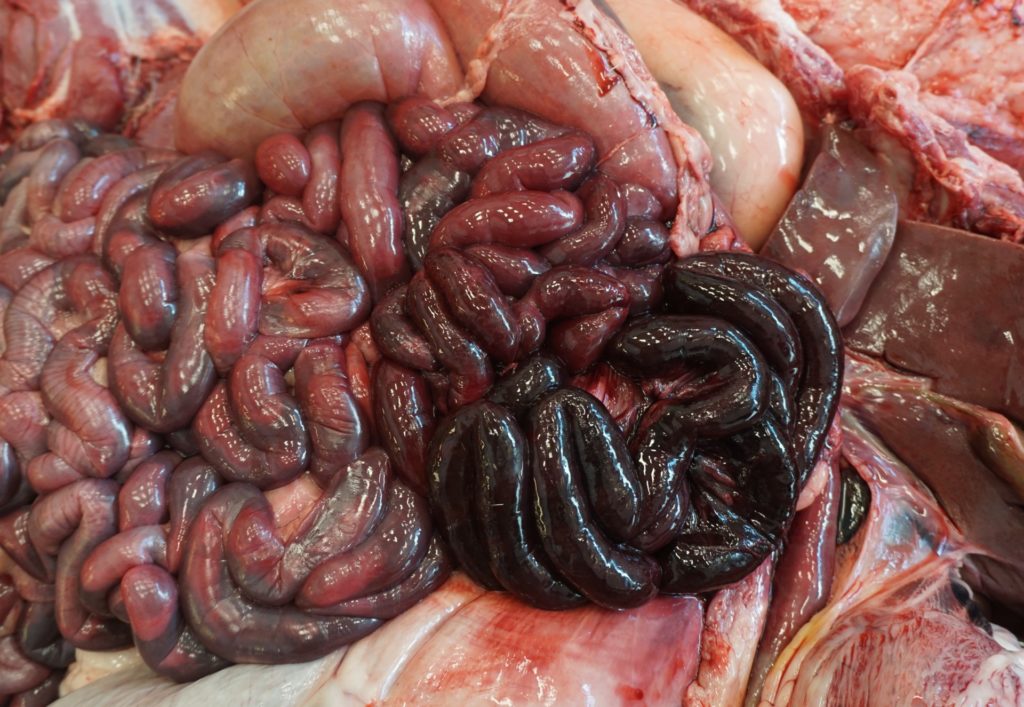Enterotoxemia:
Synonym: Pulpy kidney disease, Struck, Lamb dysentery
- It is primarily an infectious disease of ruminants that results due to absorption of toxin being formed in intestine.
- It has been reported from cattle, sheep, goat, lamb, foals and pigs.
- The disease is considered to be most important killer disease in goats.

Etiology:
- Clostridium perfringens
- Gram +ve rods, anerobic in nature
- Six strains of clostridium perfringens A to F are present out of which five strains A, B, C, D and E are important.
- Four toxins; alpha, beta, epsilon and iota produced by them causes different disease in different species. They are listed below:
|
Type (Strain) |
Disease |
|
A |
Gas gangrene, Enterotoxemia in lamb |
|
B |
Lamb dysentery |
|
C |
Struck in adult sheep, Necrotic enteritis in lamb, goat, cattle |
|
D |
Enterotoxemia in sheep, goat, cattle |
|
E |
Enterotoxemia in calves, lambs |
Epidemiology:
- Disease is prevalent worldwide.
- Clostridium are generally inhabitant of rumen microflora in ruminant animals and are found in soil in environment.
- Disease is common in intensively managed flock fed on concentrate ration than in grazing sheep
- Highest incidence is reported in lamb between 3-10 weeks of age.
- Morbidity is around 10% and mortality reaches upto 100% usually in Oct. to Dec.
Pathogenesis:

Clinical Findings:
Type- A:
- Enterotoxemic jaundice is seen in sheep and cattle.
- Intense icterus, haemoglobinaemia and hemoglobinuria.
- Animals shows respiratory distress
- Bloody foam from mouth and nostrils.
- Pulmonary emphysema may occur due to type A infection.
Type- B:
- This organism produces alpha, beta and epsilon toxin.
- Severe dysentery in affected lamb
- Severe abdominal pain, spasms, aimless wandering
- Sudden death without any signs.
Type-C:
- It affects sheep, goat and cattle. It produces hemorrhagic enterotoxemia.
- Abdominal pain, weakness, depression, failure to suckle milk
- Hemorrhagic diarrhea
Type- D:
- It produces alpha toxin and primarily disease of sheep but cattle and goats are occasionally affected.
- Affected lamb may jump in air, fall in ground, go into convulsion and die within few minutes.
- Sheep dies suddenly without any lesion.
PM findings:
Type-B:
- In case of lamb dysentery, small necrotic areas, surrounded by zone of hemorrhages are noted in intestinal mucosa.
- Enlargement of mesenteric lymph nodes
- Liver is enlarged and friable.
Type- C:
- Hemorrhagic changes in jejunum and ileum
- Necrotic and ulcerative changes in intestine
- Small hemorrhagic lesion may be noted in epicardium, thymus and diaphragm.
Type- D:
- Diffuse reddening of abomasal mucosa
- Hemorrhages in sub-endocardial and myocardial layer of heart.
- Animal may become blind due to affection in CNS


- Straw colored fluid is found in peritoneal, pleural and pericardial sac.
- Most striking lesion is autolytic changes in kidney. Due to autolysis, kidney becomes soft and pulpy, hence named pulpy kidney disease.
- Sheep may develop glycosuria, so called over eating disease.

Type-E:
- There is fatal infection leading to death.
- Hemorrhagic changes in intestine.
Diagnosis:
- Diagnosis is made on basis of history of spread of disease; sudden death in animals following changes in diet and stress.
- Based on clincal findings
- Based on PM findings
- Demonstration of toxin by mouse inoculation test
- Isolation of gram+ve bacilli in intestinal smear usually indicates enterotoxemia.
Differential Diagnosis:
- Polioencephalomalacia (PEM):
- No pulpy kidney and isolation of epsilon toxin
- Cortical necrosis is evident
- Hypomagnesemia:
- Sudden death, convulsion in grazing animals
- No kidney or brain lesion as in enterotoxemia
- Listeriosis:
- Circling, head tilt and head pressing are evident.
- No pulpy kidney lesion is seen.
- Rabies:
- Animals shows aggression before developing neurological signs
- History of bite of rabid animal
- Not sudden mass mortality
- Lead poisoning:
- History of exposure to lead
- No pulpy kidney lesions
- Nervous signs, blindness
- Pregnancy toxemia in sheep:
- Occurs in late gestation
- Neurological signs, ketone odor is evident
- Recumbency in affected sheep
Treatment:
- No satisfactory treatment is available due to rapid course of disease.
- In some cases, treatment is of no value due to severe effect of toxin.
- Oral antibiotics such as tetracycline, chlortetracycline and penicillin may be tried.
Control Measures:
- Calves, lambs should be immunized with antitoxin soon after birth to control disease.
- Two injections of toxoids are necessary at one month apart.
- Sudden changes in diet of animals should be avoided.
- Adequate forages; rough forages should be provided to slow intestinal transit.
- Excess grain or highly digestible carbohydrates should be restricted in animal.
- Dead carcass should be disposed of properly. It should be either buried or burnt properly to avoid environmental contamination.